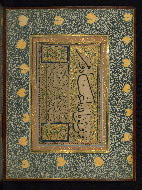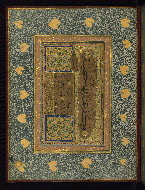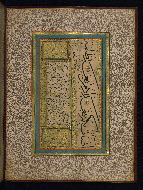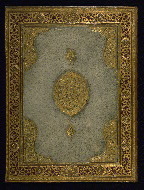Home > Digitized Walters Manuscripts
This document is a tranformation of a TEI P5 XML manuscript description incorporating images. If you have trouble reading special or non-Latin characters on this page, please make sure you have appropriate Unicode fonts installed and an up-to-date web browser.
Walters Ms. W.672, Album of Ottoman calligraphy
Browse images (Browse images in a new window) | TEI in XML format
W.672
Album of Ottoman calligraphy
Vernacular: مرقع
This album (muraqqaʿ) of calligraphy in an accordion format was compiled in Ottoman Turkey in the twelfth century AH / eighteenth CE. It consists of leaves bearing fragmentary passages from the Qur’an (chapter 2 [Sūrat al-baqarah], 2:65-68 and chapter 4 [Sūrat al-nisāʾ], 4:103-106); sayings of the Prophet Muhammad (hadith); and two sheets of pen exercises (ḳaralama). The Qur'anic verses and the passages of hadith are written in vocalized naskh and thuluth scripts in black ink. Fol. 5a bears the name of the Ottoman calligrapher Şeyh Hamdullah (Ḥamd Allāh al-Amāsī, d. 926 AH / 1520 CE). Şeyh Hamdullah was the most celebrated calligrapher of his time and influenced subsequent generations of calligraphers. Each page in the album is framed by eighteenth-century marbled borders. The sheepskin binding with central lobed medallion has a central panel filled with chamois leather and probably dates to the twelfth century AH / eighteenth CE.
10th century AH / 16th CE -- 12th century AH / 18th CE
Turkey
As-written name: Ḥamd Allāh al-maʿrūf bi-Ibn al-Shaykh
Name, in vernacular: حمد الله المعروف بابن الشيخ
Known as: Ibn al-Shaykh
Known as: Ḥamd Allāh al-Amāsī
Note: Ḥamd Allāh al-Amāsī, known as Ibn al-Shaykh or Şeyh Hamdullah (d. 926 AH / 1520 CE), was the most important calligrapher of the early Ottoman period.
Album
The primary language in this manuscript is Arabic.
- Transliteration: katabahu Ḥamdu Llāhi al-maʿrūfu /1/ bi-ibni al-shaykhi ḥāmidan li-Llāhi taʿālá wa-muṣalliyan /2/ ʿalá nabīyihi Muḥmammadin wa-ālihi al-ṭāhirīna /3/ ajmaʿīna /4/ wa-musalliman fī awāni shaybihi maʿa ishtiʿāl shaʿrihi wa-irtiʿāsh raʾsihi qaribun mina ardhali [?] al-ʿummá [sic] huwa [?] ibn [?] biḍaʿin [?] wa-thamānina min ʿumrihi /5/ wa-raḥima Allāhu man anṣafa fa-ʿafā wa-naẓara fa-daʿā li-anna al-insāna ḥull [?] bi-al-niqṣān fa-hā anā al-mawṣūf bi-al-nisyāni wa-al-ʿiṣyāni /6/
- Translation: This was written by Ḥamdu Llāh, [who is] known as the sheikh's son, [while] praising God--exalted is he--and praying for his messenger Muhammad and his family, the pure ones, all of them, and praying for their safety. [This was] at the time of his hoariness, as his hair glistened white and his head trembled and he was close to the state of decrepitude, being 80 and some odd years old. May God have mercy on those who act equitably and forgive and those who consider [things] closely and pray, because mankind was made to abide in deficiency and here am I, characterized by forgetfulness and disobedience.
- Comment: Fully vocalized colophon giving the name of the calligrapher, Ḥamd Allāh al-maʿrūf bi-Ibn al-Shaykh, and stating that it was executed when he was 80 years old
Paper
Mounted on thin pasteboard
Foliation: 10
Leaves have been numbered 1-5 for digitization purposes; text apears only on one side of the conjoint leaf
Catchwords: None
23.0 cm wide by 30.0 cm high
- Columns: 1
- Ruled lines: 5-11
- Title: Muraqqa`
- Scribe: Ḥamd Allāh al-maʿrūf bi-Ibn al-Shaykh
- Incipit: ورحمته لكنتم من الخاسرين ...
- Hand note: Written in calligraphic, vocalized naskh and thuluth scripts in black ink
- Decoration note: Decorated marbled borders; polychrome illuminated frames; polychrome floral motifs on a gold ground; illuminated verse markers
Upper board outside:
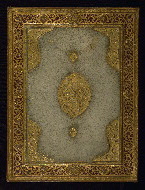
- Title: Binding
- Form: Binding
- Label: This sheepskin-covered binding, with central lobed medallion and central pane filled with chamois leather, was produced in Ottoman Turkey and probably dates to the twelfth century AH / eighteenth CE.
fol. 1b:
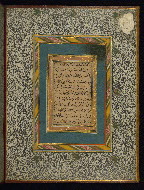
- Title: Calligraphic page with verses from chapter 2 of the Qur'an
- Form: Album page of calligraphy
- Text: Chapter 2 (Sūrat al-baqarah), 2:65-68
- Label: This calligraphic page with verses from chapter 2 (Sūrat al-baqarah) 2:65-68 is framed by an outer border of marbled paper.
fol. 2a:
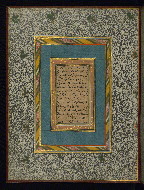
- Title: Calligraphic page with verses from chapter 4 of the Qur'an
- Form: Album page of calligraphy
- Text: Chapter 4 (Sūrat al-nisāʾ), 4:103-106
- Label: This calligraphic page with verses from chapter 4 (Sūrat al-nisāʾ) 4:103-106 is framed by an outer border of marbled paper.
fol. 2b:
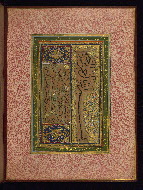
- Title: Page of Ottoman calligraphy
- Form: Album page of calligraphy
- Label: This page is inscribed with passages from hadith literature (accounts of what the Prophet Muhammad did or said) and is written in naskh and thuluth scripts. Naskh, the smaller hand, is used for the text on the lower portion, while thuluth (the larger hand) is used for the top lines.
fol. 3b:
fol. 4a:
fol. 4b:
fol. 5a:
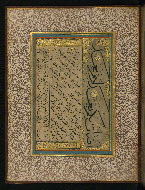
- Title: Page of Ottoman calligraphy
- Form: Album page of calligraphy
- Label: This page bears the name of the celebrated Ottoman calligrapher Şeyh Hamdullah (Ḥamd Allāh al-Amāsī, d. 926 AH / 1520 CE). The colophon may be translated into English as follows: This was written by Ḥamdu Llāh, [who is] known as the sheikh's son, [while] praising God--exalted is he--and praying for his messenger Muhammad and his family, the pure ones, all of them, and praying for their safety. [This was] at the time of his hoariness as his hair glistened white and his head trembled and he was close to the state of decrepitude, being 80 and some odd years old. May God have mercy on those who act equitably and forgive and those who consider [things] closely and pray, because mankind was made to abide in deficiency and here am I, characterized by forgetfulness and disobedience.
fol. 5b:
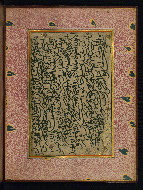
- Title: Page of pen exercises
- Form: Album page of calligraphy
- Label: This is a sheet of pen exercises (ḳaralama). Such pen exercises were commonly collected in albums. In their technique and design pattern, the borders of this page are comparable to ebru (marbled paper) made by Hatib Mehmed Efendi (d. 1187 AH / 1773 CE), a celebrated Ottoman artist.
fol. 6a:
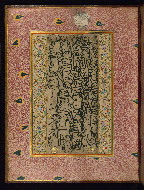
- Title: Page of pen exercises
- Form: Album page of calligraphy
- Label: This is a sheet of pen exercises (ḳaralama). Such pen exercises were commonly collected in albums. In their technique and design pattern, the borders of this page are comparable to ebru (marbled paper) made by Hatib Mehmed Efendi (d. 1187 AH / 1773 CE), a celebrated Ottoman artist.
Lower board outside:
The binding is not original.
Probably dates to the twelfth century AH / eighteenth CE; sheepskin-covered boards; central oval medallion; pendants and cornerpieces; gold-painted border; central panel filled with chamois leather
Walters Art Museum, 1931, by Henry Walters bequest
Principal cataloger: Gacek, Adam
Catalogers: Landau, Amy; Smith, Sita
Editor: Bockrath, Diane
Conservators: Jewell, Stephanie; Quandt, Abigail
Contributors: Barrera, Christina; Emery, Doug; Herbert, Lynley; Noel, William; Simpson, Shreve; Tabritha, Ariel; Toth, Michael B.; Valle, Chiara
The Walters Art Museum
Licensed for use under Creative Commons Attribution-NonCommercial-ShareAlike 3.0 Unported Access Rights, http://creativecommons.org/licenses/by-nc-sa/3.0/legalcode. It is requested that copies of any published articles based on the information in this data set be sent to the curator of manuscripts, The Walters Art Museum, 600 North Charles Street, Baltimore MD 21201.
